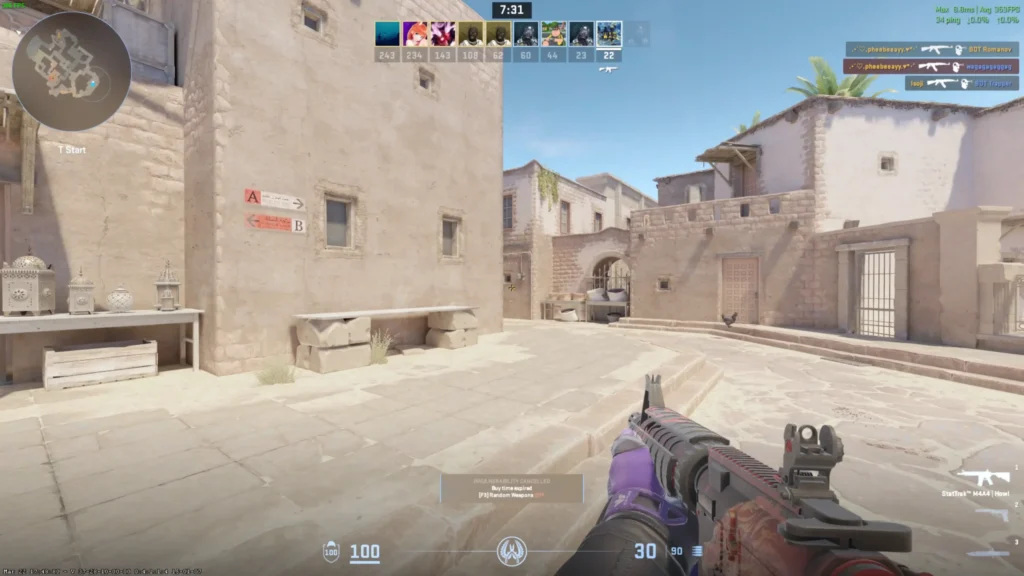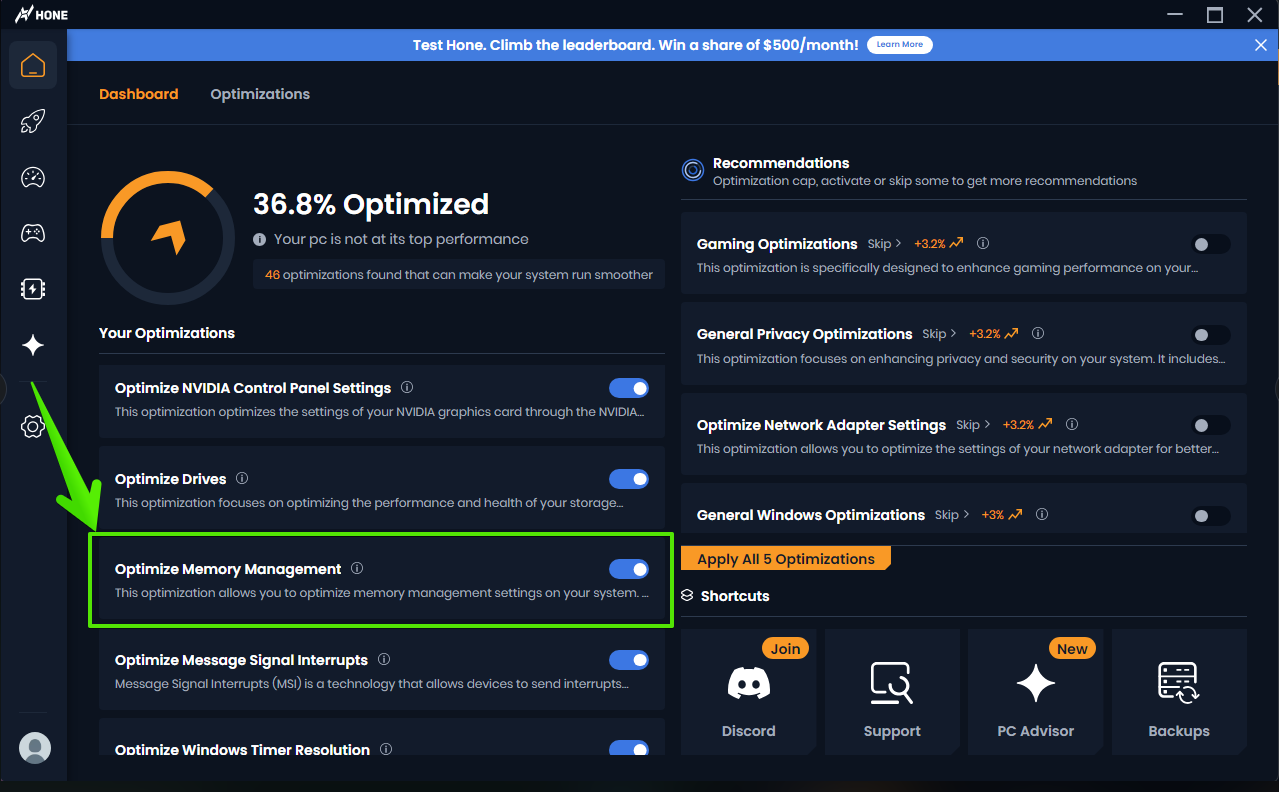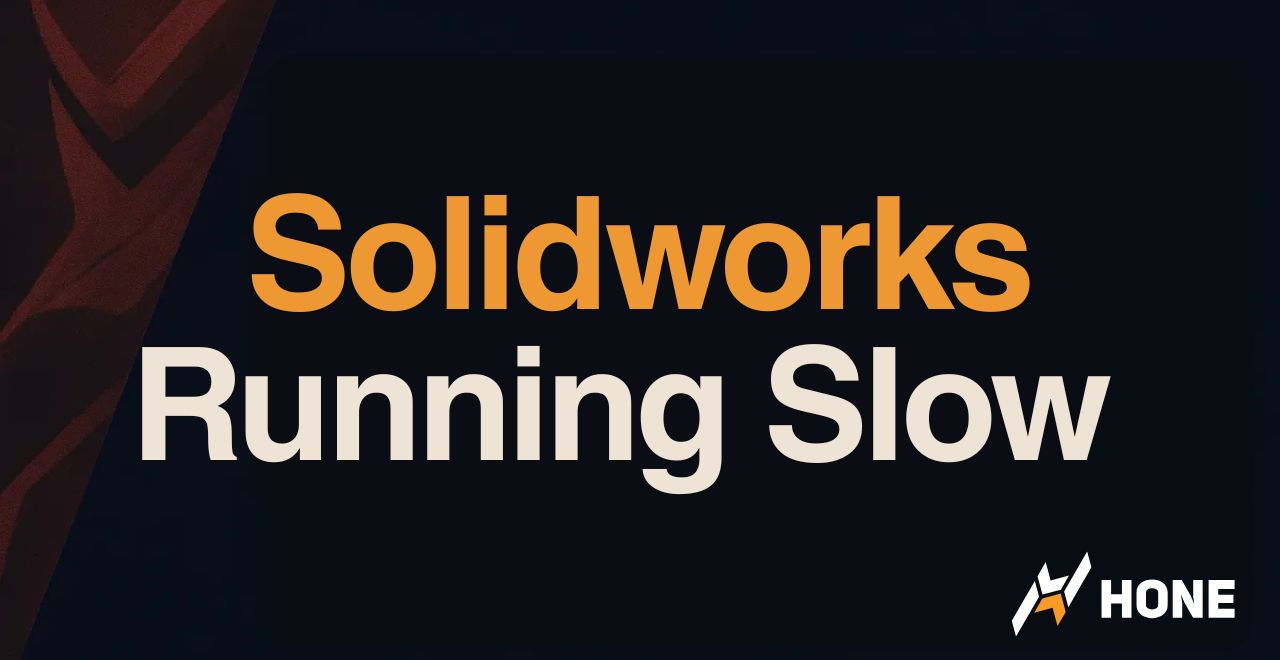Nothing tilts harder than stuttering in CS2. One second you’re lining up the perfect shot, the next your screen hiccups, and you’re back in spawn. These micro-freezes kill momentum and cost rounds, fast.
This guide tackles Counter-Strike 2 stuttering head-on, with 12 fixes if CS2 feels laggy; from sneaky background bottlenecks to engine-level tweaks.
Identifying Your CS2 Stuttering Type
Before applying fixes, it’s important to identify exactly what type of stuttering you’re experiencing. Different causes require different solutions, and diagnosing the specific problem will save you time and frustration.
Characterized by irregular hitches that occur regardless of what’s happening on screen. Your FPS counter may show high numbers, but gameplay feels inconsistent.
- Random microfreezes during gameplay
- High average FPS but inconsistent feeling
- Worse after extended play sessions
- May coincide with disk activity
- Often CPU or memory-related
Performance drops that consistently occur during specific in-game scenarios, particularly during smoke grenades, flashbangs, or when encountering enemies.
- Stutters during smoke grenades/flashbangs
- Freezes when first seeing enemies
- Hitches during intense firefights
- First-time effects causing lag
- Usually shader or GPU-related
Although technically a different issue, network problems can manifest symptoms similar to performance stuttering, making diagnosis tricky.
- Rubber-banding or teleporting
- Other players move erratically
- Delayed damage registration
- Loss % or choke % in net_graph
- Consistent ping spikes
Happens when the game needs to load assets from your storage drive, causing momentary freezes while waiting for data.
- Stutters when entering new areas
- Disk activity indicator flashing during freezes
- First round is worse than subsequent rounds
- Improves after playing the same map repeatedly
- Usually HDD-related or fragmentation issues
Answer these questions to help identify the most likely cause of your CS2 stuttering:
Based on your answers, refer to the solutions below that best match your situation. For random stutters with high FPS, focus on Solutions #1, #2, and #6. For effect-related stuttering, prioritize Solutions #3, #5, and #7.
12 Solutions to Fix CS2 Stuttering

Now that you’ve identified your stuttering type, here are 12 targeted solutions to resolve your specific CS2 performance issues. Start with the solutions most relevant to your stutter pattern for the best results.
Clear Windows Standby Memory High Impact
Windows’ memory management system can cause stuttering by filling your standby memory list with cached data that isn’t properly cleared. This is one of the most common causes of stuttering in CS2, especially after extended play sessions.
1. Download Hone from hone.gg 2. Install and launch the app 3. Navigate to the "Dashboard" tab 4. Scroll to "Optimize Memory Management" under Your Optimizations 5. Toggle it on to apply memory tuning automatically 6. Leave Hone running in the background while playing CS2

This fix is especially helpful for mid-range systems (16GB RAM or less) and longer CS2 sessions where performance degrades over time. Hone’s memory tuning directly reduces stutters tied to memory allocation issues.
Fix Frame Time Issues with RTSS High Impact
Frame time inconsistency is a major cause of perceived stuttering, even when your average FPS is high. RivaTuner Statistics Server (RTSS) provides a more consistent frame pacing by capping your frame rate using a superior frame time limiting method.
- Download and install MSI Afterburner with RTSS from the official website
- Open RTSS (it should be in your system tray after installation)
- Add CS2 to the application list:
- Click the “+” button and navigate to your CS2 executable (usually in C:\Program Files (x86)\Steam\steamapps\common\Counter-Strike Global Offensive\game\bin\win64\cs2.exe)
- Set “Framerate limit” to a value slightly below your average FPS (e.g., 240 if you normally get 250-300)
- Enable “Frame time limit method” instead of “Frame rate limit method”
- In CS2 console, enter:
fps_max 0to let RTSS handle the frame limiting - Enable the frame time graph in MSI Afterburner’s monitoring settings to visualize frame time consistency
This solution works by ensuring each frame takes a consistent amount of time to render, eliminating the micro-stutters caused by inconsistent frame pacing. It’s particularly effective for high-end systems that show high FPS but still experience stuttering.
Pre-Cache Shaders for Smoother Gameplay High Impact
CS2’s Source 2 engine compiles shaders in real-time when it encounters new effects, causing stutters the first time you see smoke grenades, muzzle flashes, or certain map elements. Pre-caching these shaders can significantly reduce first-encounter stuttering.
- Enable shader pre-caching in Steam:
- Open Steam → Settings → Shader Pre-Caching
- Check “Enable Shader Pre-Caching”
- Check “Allow background processing of Vulkan shaders”
- Set an appropriate cache size based on your available storage
- Add these Launch Options:
-d3d9ex -high +mat_compressedtextures 1 - Enable Uber Shaders in CS2’s advanced video settings
// Execute these commands in the CS2 console
r_shader_preload 1 // Preloads shaders
r_shader_preload_immediate 1 // Forces immediate preloading
mat_queue_mode 2 // Forces multi-threaded material loading
r_shader_dump_assets 0 // Disables shader asset dumping
cl_phys_timescale 8 // Accelerates physics (during preload only)
This solution specifically targets the situational stutters that occur when encountering new visual effects for the first time. Once shaders are cached, they won’t need to be recompiled until the game updates.
Repair CS2 Shader Cache Medium Impact
Corrupted shader caches can cause persistent stuttering that worsens over time. Clearing and rebuilding the shader cache can solve stubborn stuttering issues, especially after game updates.
- Close CS2 and Steam completely
- Delete the shader cache files:
- Navigate to:
C:\Program Files (x86)\Steam\steamapps\shadercache\730 - Delete all contents within this folder (but not the folder itself)
- Navigate to:
- Clear GPU shader cache:
- For NVIDIA:
- Set “cache size” to “Disabled” in the Nvidia Control Panel
- Type %localappdata% in the Windows search bar
- Navigate to the NVIDIA folder
- Delete the contents of the DXCache and GLCache folders
- Set cache size back to Driver Default in the Nvidia Control Panel
- For AMD: Open AMD Software → Settings → Graphics → Reset Shader Cache
- Verify game files integrity:
- Open Steam → Library → Right-click CS2 → Properties → Local Files → Verify integrity of game files
- Restart your computer and launch CS2
- Allow shader recompilation: Join an offline game and move around the map to trigger shader compilation
This solution effectively gives your shader system a clean slate, forcing the game to rebuild a fresh shader cache. It’s particularly effective after game updates or driver changes that might have caused incompatibilities in the existing cache.
Eliminate CPU Thread Contention High Impact
CS2 is particularly sensitive to CPU thread contention issues, where background processes compete with the game for CPU resources. Optimizing CPU priority and process management can significantly reduce stuttering on all system types.
1. Download Process Lasso from Bitsum's website 2. Install and run the application 3. Find cs2.exe in the process list 4. Right-click cs2.exe → CPU Affinity → Always → Select all cores except 0 (This reserves core 0 for Windows and background tasks) 5. Right-click cs2.exe → Disable ProBalance for this process 6. Enable "Save settings for cs2.exe"
Additionally, disable these CPU-intensive background processes before playing:
- Disable Windows services that impact performance:
- Windows Search (heavy indexing)
- Superfetch/SysMain (memory management conflict)
- Windows Update (background downloading)
- Close resource-intensive applications:
- Web browsers (particularly Chrome)
- Video editing/rendering software
- Other games or launchers
- Cloud synchronization tools (OneDrive, Dropbox)
This comprehensive approach ensures CS2 receives prioritized CPU access while preventing other processes from causing stutters through CPU resource competition.
Fix Volumetric Smoke Stuttering High Impact
CS2’s new volumetric smoke system is one of the most common causes of situational stuttering. These targeted settings specifically reduce smoke-related performance issues without significantly impacting visibility.
- Optimize graphics settings specifically for smoke performance:
- Effect Detail: Set to Low
- Shader Detail: Set to Low
- Particle Detail: Set to Low
- Add these launch options:
-d3d9ex +r_dynamic 0 - Apply these console commands:
r_particle_timescale 1.15(Slightly accelerates particle effects)violence_ablood 0(Disables blood effects)func_break_max_pieces 0(Reduces physics objects)
- Bind a key to clear decals: Add
bind shift "+speed;r_cleardecals"to clear visual debris while walking
1. Open NVIDIA Control Panel
2. Go to Manage 3D Settings -> Program Settings -> Add CS2
3. Configure these settings specifically:
• Texture filtering - Negative LOD bias: Allow
• Texture filtering - Quality: Performance
• Texture filtering - Trilinear optimization: On
• Power management mode: Prefer maximum performance
• Shader Cache: Unlimited
4. Apply settings and restart the game
This solution specifically targets the notorious smoke grenade stuttering that affects many players, even those with high-end systems. The settings reduce the computational load of volumetric smoke without compromising your ability to play effectively.
Fix Driver Latency Issues Medium Impact
Certain system drivers can cause significant latency spikes that manifest as stuttering. Identifying and addressing problematic drivers can resolve persistent stuttering that other methods don’t fix.
- Identify high-latency drivers with LatencyMon:
- Download LatencyMon and install it
- Close all applications except CS2
- Run LatencyMon, click “Start” and play CS2 for 15-20 minutes
- Return to LatencyMon and check the “Drivers” tab
- Note any drivers with high “Highest execution” or “Total execution” times
- Common problematic drivers to address:
- Audio drivers (especially Realtek with “Waves MaxxAudio”)
- Network drivers (especially Killer Network drivers)
- Storage controller drivers
- RGB/peripheral software drivers
- NVIDIA graphics drivers
- Update or replace high-latency drivers:
- Download the latest version directly from the manufacturer
- Consider using the Microsoft generic driver instead of vendor-specific drivers
- For audio issues, try disabling audio enhancements in Sound control panel
- For NVIDIA issues, set Power Management Mode in the Nvidia Control Panel to “Prefer Maximum Performance” and restart your PC
// For Realtek and similar audio solutions:
1. Right-click sound icon in system tray → Open Sound settings
2. Click "Sound Control Panel" on the right
3. Right-click your playback device → Properties
4. Go to the "Enhancements" tab
5. Check "Disable all enhancements" (or disable specific effects)
6. Go to the "Advanced" tab
7. Uncheck "Allow applications to take exclusive control"
8. Set format to 16 bit, 48000 Hz for optimal latency
9. Click Apply → OK
This solution targets system-level causes of stuttering that are often missed by game-specific optimizations. It’s particularly effective for stutters that occur across multiple games and applications.
Resolve Storage Bottlenecks Medium Impact
CS2’s Source 2 engine loads assets differently than the original CS:GO, making storage performance more important. Slow or fragmented storage can cause stutters when the game loads new assets.
- Move CS2 to an SSD:
- In Steam, right-click CS2 → Properties → Local Files → Move Install Folder
- Select a location on an SSD drive
- Let Steam transfer the files
- Defragment (HDD) or trim (SSD) your drive:
- Open File Explorer → Right-click the drive → Properties
- Tools tab → Optimize → Select the drive → Analyze
- If fragmentation is over 10%, click “Optimize”
- Enable CS2’s texture streaming:
- In CS2 video settings, enable “Texture Streaming”
- This allows the game to manage texture loading more efficiently
- Preload map assets with this console command:
cl_forcepreload 1
If you must use a mechanical hard drive for CS2, ensure it has at least 20% free space and is regularly defragmented. Consider using ReadyBoost with a high-speed USB drive to supplement your HDD performance if upgrading to an SSD isn’t an option.
This solution specifically addresses storage-related stutters that typically occur when entering new map areas or encountering new game elements. It’s especially important for players using mechanical hard drives or older/slower SSDs.
Optimize Network Settings Medium Impact
Network-related issues can manifest symptoms similar to performance stuttering. Optimizing your network settings can resolve what appears to be stuttering but is actually network lag or packet loss.
- Diagnose network issues:
- In CS2 console, type:
net_graph 1 - Look for “loss” (packet loss) or “choke” percentages above 0%
- Check for large ping fluctuations
- In CS2 console, type:
- Apply optimal CS2 network settings:
rate 786432(Maximum bandwidth for stable connections)cl_updaterate 128(Match server tickrate)cl_cmdrate 128(Match server tickrate)cl_interp 0(Minimize interpolation)cl_interp_ratio 1(For stable connections) or2(For less stable connections)cl_predict 1(Enable client-side prediction)cl_predictweapons 1(Enable weapon prediction)
- Network hardware improvements:
- Use wired ethernet instead of Wi-Fi whenever possible
- Close bandwidth-intensive applications (downloads, streams, etc.)
- For Wi-Fi users, select less congested channels in router settings
This solution addresses network-related issues that can be mistaken for performance stuttering. It’s particularly relevant for players who notice the stuttering coincides with enemy encounters or high-action moments, which involve more network activity.
Fix Thermal Throttling High Impact
Thermal throttling occurs when your CPU or GPU reduces its performance to prevent overheating. This commonly causes stuttering that worsens over time during a gaming session.
- Monitor temperatures during gameplay:
- Use MSI Afterburner or HWiNFO to monitor CPU and GPU temperatures
- Look for temperatures above 80°C on the CPU or 83°C on the GPU
- Watch for clock speed drops that coincide with temperature spikes
- Improve cooling solutions:
- Clean dust from fans, heatsinks, and air intakes
- Ensure proper case airflow (typically 2+ intake fans, 1+ exhaust fans)
- Replace thermal paste on CPU and GPU if it’s over 2 years old
- Consider upgrading to a better CPU cooler if using the stock cooler
- Adjust fan curves for better cooling:
- In MSI Afterburner: Fan tab → Enable user defined fan control
- Create an aggressive curve that increases fan speed at lower temperatures
- For laptops, use a cooling pad and elevate the rear for better airflow
// For NVIDIA GPUs:
1. Open MSI Afterburner
2. Press Ctrl+F to open the voltage/frequency curve editor
3. Press L while selecting a point around 850-950mV
4. Click Apply to lock the voltage at this level
5. Test stability in CS2, adjust if needed
// For Intel CPUs (requires Intel XTU or ThrottleStop):
1. Start with a -80mV core voltage offset
2. Test stability with a stress test
3. If stable, try reducing in -10mV increments
4. Stop when you encounter instability and revert to last stable setting
This solution is crucial for laptops and compact desktop systems that are prone to thermal limitations. By addressing thermal throttling, you eliminate one of the most common causes of progressively worsening stuttering during extended play sessions.
Create a Performance-Focused Autoexec File High Impact
An autoexec.cfg file containing optimized performance commands can address multiple causes of stuttering simultaneously. This comprehensive solution combines the most effective settings from other solutions into one configuration file.
- Create the autoexec.cfg file:
- Navigate to:
...\Steam\steamapps\common\Counter-Strike Global Offensive\game\csgo\cfg\ - Create a new text file named “autoexec.cfg”
- Open it with Notepad or any text editor
- Navigate to:
- Copy the optimized performance commands below into the file
- Save the file and ensure it has the .cfg extension (not .txt)
- Add +exec autoexec to your launch options to ensure it loads
// Anti-Stuttering Performance Config for CS2 // ========================================== // FPS and Performance Settings fps_max 0 // Uncapped FPS (or set to stable value below your average) fps_max_menu 60 // Limit menu FPS to save resources r_dynamic 0 // Disable dynamic lighting cl_disablehtmlmotd 1 // Disable server messages cl_forcepreload 1 // Preload map assets cl_disable_ragdolls 1 // Disable ragdoll physics mat_queue_mode 2 // Multi-threaded material system r_shader_preload 1 // Preload shaders r_shader_preload_immediate 1 // Force immediate shader preloading violence_ablood 0 // Disable blood effects func_break_max_pieces 0 // Reduce physics objects r_particle_timescale 1.15 // Slightly accelerate particles snd_async_flush // Flush sound cache r_cleardecals // Clear decals on startup // Network Optimization rate 786432 // Max bandwidth cl_cmdrate 128 // Command rate cl_updaterate 128 // Update rate cl_interp 0 // Minimum interpolation cl_interp_ratio 1 // Interp ratio for stable connections cl_lagcompensation 1 // Enable lag compensation net_maxroutable 1200 // Max packet size net_splitrate 2 // Packet splitting // Memory Management mat_managedtextures 1 // Improved texture management mem_level 2 // Memory management level // Bind useful performance commands to keys bind "f7" "r_cleardecals" // Clear visual debris bind "shift" "+speed;r_cleardecals" // Clear decals while walking // Apply settings and confirm host_writeconfig // Write to config echo "============================" echo "Anti-stutter config loaded!" echo "============================"
The autoexec approach provides a persistent solution that automatically applies every time you launch CS2, ensuring you don’t have to manually re-enter commands after game updates or setting changes.
?Still Experiencing Stutters?
If you’ve tried all applicable solutions and still experience stuttering, consider these last-resort options:
- Completely Reinstall CS2:
- Uninstall CS2 through Steam
- Navigate to the installation folder and delete any remaining files
- Delete the CS2 folder in
C:\Program Files (x86)\Steam\userdata\[your-id]\730\ - Download and install a fresh copy
- Try a Clean Windows Installation:
- Create a backup of important files
- Perform a clean Windows installation (not just a reset)
- Install only essential drivers and Steam before testing CS2
- Hardware-Specific Solutions:
- If RAM limited (8GB or less): Consider upgrading to 16GB dual-channel
- If using HDD: Upgrading to an SSD is almost mandatory for CS2
- Older CPUs (pre-2017): Consider CPU upgrade as highest priority
Remember that some level of frame time variance is normal in CS2’s Source 2 engine, especially during smoke grenades. If stutters are minimal and only occur in specific situations, you might have reached the optimization limit for your current hardware.
Advanced Troubleshooting for Persistent Stuttering
For players experiencing stubborn stuttering issues that don’t respond to the standard solutions, these advanced diagnostic approaches can help pinpoint the exact cause of your CS2 performance problems.
Using FrameView for Detailed Performance Analysis
NVIDIA’s FrameView tool provides comprehensive performance metrics that can identify the exact source of stuttering issues:
- Download FrameView from NVIDIA’s website
- Install and run the application
- Configure it to monitor CS2
- Play CS2 for at least 15 minutes, ensuring you encounter the stuttering
- Stop the capture and analyze the results, paying special attention to:
- Frame time spikes (not just average FPS)
- CPU render time vs. GPU render time (to identify bottlenecks)
- Power consumption vs. performance (potential throttling)
- PresentMon metrics for driver overhead
The performance graphs will show exactly when stutters occur, helping you correlate them with specific in-game events or system activities.
Windows Event Viewer Analysis
System-level issues often leave traces in Windows Event Viewer that can reveal the cause of stuttering:
- Press Win+X and select “Event Viewer”
- Expand “Windows Logs” and click on “System”
- Look for Error or Warning events that coincide with your gaming sessions
- Common culprits to watch for:
- DCOM or Service Control Manager errors
- Kernel-Power warnings
- Driver timeouts (often nvlddmkm for NVIDIA or atikmpag for AMD)
- Disk errors or NTFS issues
These events can reveal system-level issues that manifest as game stuttering, such as power delivery problems, driver conflicts, or background service interruptions.
Process Monitor for Resource Conflicts
For stubborn stuttering issues, Process Monitor can reveal exactly which processes are accessing resources during stutter events:
- Download Process Monitor from Microsoft’s Sysinternals site
- Run the application as Administrator
- Set up these filters to reduce noise:
- Include Process Name is cs2.exe
- Include Process Name is System
- Include Result is ACCESS DENIED
- Include Operation is ReadFile
- Include Operation is WriteFile
- Clear the display (Ctrl+X), then start capturing
- Play CS2 until stuttering occurs, then immediately stop capturing
- Look for patterns in the timeline view that coincide with stutter moments
This advanced approach can reveal specific file access conflicts, antivirus interventions, or background process interruptions that cause microstutters in CS2.
Tired of manually implementing all these fixes? Hone.gg automatically detects and resolves CS2 stuttering issues with a single click.
Our specialized gaming performance software implements all the tweaks in this guide, continuously monitors your system, and maintains peak performance for CS2 and other competitive games.
Enjoying Stutter-Free CS2 Performance
Resolving CS2 stuttering often requires a combination of solutions tailored to your specific system and the type of stuttering you’re experiencing. By identifying your particular stuttering pattern and applying the targeted fixes in this guide, you can achieve smoother, more consistent performance that gives you the competitive edge in Counter-Strike 2.
Creating a regular maintenance routine that includes shader preloading, standby memory clearing, and temperature monitoring will help ensure your CS2 experience remains smooth and competitive.
Frequently Asked Questions
Why do I get stutters in CS2 despite having high FPS?
High FPS doesn’t always mean smooth gameplay. Frame time inconsistency is often the culprit, causing stutters. Solutions include clearing standby memory, preloading shaders, and capping FPS using tools like RTSS for consistent frame delivery.
Why does CS2 stutter specifically during smoke grenades?
CS2 uses volumetric smoke, which demands more from your CPU and GPU. The game calculates light, shadows, and particles in real-time, spiking frame times. Lowering Particle and Effect Detail and using r_particle_timescale can help minimize the impact.
Does RAM speed actually affect stuttering in CS2?
Yes, RAM speed and dual-channel configuration greatly impact CS2’s frame times. Enabling XMP/DOCP and using faster RAM (3200MHz+) reduces stutters. Dual-channel improves bandwidth, reducing frame time spikes. Lower CAS latency further enhances memory performance.
How can I tell if my stuttering is caused by network lag or performance issues?
Performance stutters affect FPS and frame timing; net stutters involve rubber-banding and delayed actions. Use net_graph 1: if packet loss or choke % spikes, it’s network; if not, it’s performance. Offline testing also reveals the root cause.
Should I cap my FPS to reduce stuttering in CS2?
Capping FPS stabilizes frame times by reducing power state and clock speed fluctuations. Use RTSS with “Frame time limit method” and cap 3-5 FPS below your minimum sustained FPS. This is especially effective for high-end systems experiencing micro-stutters.
Why did my CS2 performance suddenly get worse after an update?
Updates can reset shaders, settings, and introduce new effects. Verify game files, rebuild shader caches, reapply optimized settings, and update GPU drivers. Shader recompilation during gameplay can also cause temporary stutters.






 Discord
Discord
 Instagram
Instagram
 Youtube
Youtube
 TikTok
TikTok